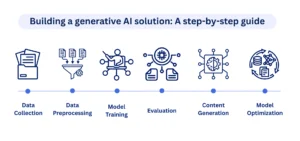Generative AI technologies are transforming the process of innovation, automation, and creation of companies in an era when they have to keep evolving in order to keep up with the competition. These technologies provide smarter ways to simplify operations and provide customized experiences, including generating original content and graphics as well as intelligent chatbots and predictive analytics. A survey shows that 91% of businesses are currently leveraging AI in their operations, a 77%rise since 2024. In this blog, the key benefits, practical applications, and a detailed tutorial to make effective generative AI applications that can transform the workflows and initiate the growth of companies will be discussed.
Why Your Business Needs Generative AI Solutions
Innovation and efficiency are no longer a luxury in the competitive present-day market; it is a business survival strategy. Generative AI solutions help organisations to optimize operations, express creativity, and deliver exceptional value. These are the main good reasons why introducing generative AI will transform your business:
Accelerates Efficiency
Generative AI simplifies the complex workflow by automating tedious and repetitive tasks. This also allows your team to focus more on innovation, problem-solving, and more value-oriented projects. The result? Optimal performance and operations.
Inspirational and Innovative
Generative AI introduces creativity to the table, unlike traditional tools of automation. It is able to create new concepts, develop alternatives, and even innovative business plans that human beings might not recognize. This encourages innovation and makes your organization remain ahead of your competitors.
Grows Productivity with Size
Businesses can also grow comfortably with the help of generative AI, which addresses multiple processes simultaneously. Such milestones include the ability to complete projects faster, efficient allocation of resources, and boosting productivity.
Saves a Lot of Money
Automation of labor-intensive processes would mean significant savings in cost. Generative AI applications reduce the need to resort to manual work, which allows investing the resources in other areas of the business that can facilitate its growth.
Strengthens Decision-Making
Generative AI can work with vast data sets in seconds to provide you with information to make better business decisions. With evidence-based suggestions with accuracy, organizations can be confident in their strategy planning and in mitigating risks.
Individualises Customer Experiences
Customers of the modern world require customization. Generative AI is used to provide personalized recommendations, dynamic services, and personalized methods of engagement – contributing to higher customer loyalty, satisfaction, and lifetime value.
Exploring the Capabilities of Generative AI Applications
It is important to know what generative AI solutions can provide before investing in them. The business can determine whether they are investing in a technology that can create quantifiable results. Furthermore, hiring an experienced AI development company can help by assessing the fundamental capabilities of the generative AI solutions as opposed to a new technology with a nice-to-have feature.
Some real-life and high-value applications of generative AI technology in business today are:
Image and Video Generation
Generative AI is capable of generating beautiful images, improving current pictures, getting rid of the scenery, increasing the resolution, and even drawing up promotional-quality designs. Indicatively, companies are able to create original avatars, virtual holdings, or branded images within seconds, reducing design expenses and budgets.
Summarization and Text Generation
Whether it is the copy and product descriptions or even translations or executive summaries, generative AI applications enable the team to handle copy-rich assignments effectively. It speeds up processes, minimizes human input, and brings about uniformity in every communication medium.
Virtual Assistants and Conversational AI
Generative AI solutions are being used by businesses to develop advanced chatbots and copilots. These can respond to customer questions, provide onboarding advice, and provide employees with fast, smart feedback- improving both customer and employee experiences.
Data-to-Structure Conversion
Unstructured data can be hard to process. Generative AI can transform this into standardized records, design files, or JSON to enable the information to be usable and actionable to departments.
Surveillance and Fraud Prevention Powered by Artificial Intelligence
The generative AI technology is able to identify anomalies, irregularities, or even acts of fraud with the ability to analyze large volumes of data in real-time. This helps business organizations to be proactive, reduce risk, and act on crucial insights in real time.
Audio and Speech Generation
Generative AI sound applications, be they through realistic voice synthesis and dubbing, music generation, and bespoke soundscapes, are offering entertainment and education, along with marketing, new opportunities.

How to Build Generative AI Solutions: A Step-by-Step Guide
Creating an effective AI solution based on generative AI does not just need technical skills but begins with identifying the problem you wish to address and what business results you hope to achieve. It is done by designing and training AI models that produce new outputs given input data and optimize certain performance metrics.
Organizations need to have a structured approach in order to succeed. The process normally involves problem definition, data gathering, and preprocessing, selecting the appropriate generative AI solutions. Moreover, identifying appropriate models and algorithms, training and fine-tuning, and lastly, deployment of the solution into the operational environment are also important.
We are going to divide the key steps of developing successful generative AI solutions that should provide tangible business value into the following steps.
Step 1: Define the Problem and Set Objectives
Creating generative AI solutions is best achieved by the initial stage of defining the issue you wish to solve and the outcomes you want to achieve. Even the most developed generative AI technology will not be able to bring any meaningful value unless there is a clear objective.
Begin by determining the exact problem: whether you need to generate realistic images, have high-quality text, have personalized audio, or organize unstructured data. After defining the problem, map out the expected results, including style, tone, resolution, or the degree of accuracy.
The correct method is also important. Transformer models are preferable to text, whereas generative adversarial networks (GANs) are more suitable for images and visuals. Specifying the quantifiable success criteria, such as BLEU or ROUGE in text and FID in images, ensures that the progress is measurable and the solution is producing business value.
Organizations also establish a solid baseline of successful generative AI solutions by having clear goals in the initial stages.
Step 2: Collect and Manage Data for Generative AI Solutions
Every successful generative AI solution is based on high-quality data. Even the most advanced technology of generative AI cannot provide accurate results without a variety of reliable datasets. Businesses should concentrate on the collection of big datasets and relevant data, and maintain the ethical and legal requirements.
Key considerations for effective data collection to use in generative AI applications include:
- Finding credible data: Data may be in APIs, databases, proprietary records, or bespoke collections. The authenticity and performance of a model are defined by the source.
- Assurance of diversity and scale: The bigger and more diverse the data is, the more realistic and varied outputs the AI model can produce.
- Being quality and relevant: Clean, accurate, and task-specific data will limit errors and bias in the final solution.
- Consistency preprocessing: Duplicates, missing values, and other data normalization activities are useful in ensuring the data is ready to be trained.
- Sensitive information: Copyrighted or other private data should be automatically excluded using automated filters and audits to preserve compliance.
- Adherence to compliance: Laws such as GDPR and CCPA mandate companies to observe data privacy, security, and user rights.
- Version control: Data versioning tools guarantee the methodical enhancement and reproducibility of the generative AI development services.
Step 3: Process and Label Data for Generative AI Solutions
Raw data is to be refined and structured after collection and is only able to drive generative AI solutions. The right processing guarantees consistency, and correct labeling renders the data meaningful in model training. This measure is essential in enhancing reliability, reducing errors, and effective learning with generative AI technology.
Material points of data processing and labeling are:
- Checking Data: Eliminate duplicates, errors, and missing values to preserve integrity.
- Normalization: The data ranges are standardized so that the models are trained on equal footing.
- Augmentation: Add variations to datasets to enhance model diversity and resilience.
- Feature extraction: Transform raw data to quantifiable measures such as embeddings, tokens, or image attributes.
- Data splitting: Splitting into training, validation, and test sets to have a balanced evaluation.
- Labeling: Tag datasets for supervised learning to enhance results.
Refining and labeling datasets also establishes a solid base to construct correct and scalable generative AI applications by organizations.
Step 4: Select the Right Foundational Model for Generative AI
Having clean and labeled data, the next step is the choice of a foundation model of generative AI solutions. These giant pre-trained models (including GPT-4, LLaMA, Mistral, or Google Gemini) begin with time and resource savings by fine-tuning to a particular task.
The main considerations in the selection of a foundational model are:
- Task relevance: GPT is the best for text generation, LLaMA is useful with multilingual tasks, and image-based models such as DALL-E work on visual results.
- Dataset compatibility: The model should be compatible with the nature of the data used (text, image, or multimodal.
- Model size and resources: The larger models provide higher performance at the cost of increased compute power; the smaller models can be more efficient.
- Transfer learning ability: Powerful models are able to adapt to new tasks with little retraining.
- Ecosystem support: Active communities and tools (such as Hugging Face) make it easy to customize and deploy.
Organizations make sure that their generative AI solutions are scalable and efficient by aligning the model choice with task requirements, data type, and available resources.
Step 5: Fine-Tuning Generative AI Models and Applying RAG
Fine-tuning and Retrieval-Augmented Generation (RAG) is the next phase in the generative AI development services after choosing a foundational model. These methodologies will make sure that generative AI solutions are context-sensitive, accurate, and aligned to business goals.
Fine-tuning generative AI models
Customization Fine-tuning pre-trained models, such as GPT or LLaMA, towards specific tasks, such as in real-world settings, can be more useful. The process involves:
- Organising domain-specific data to train.
- Tuning parameters and layers to create task-relevant outputs.
- Leveraging optimization techniques, such as the use of different learning rates.
- Regularization techniques to avoid overfitting and to enhance generalization.
RAG of generative AI solutions
Retrieval-Augmented Generation (RAG) augmentation of generative models adds external sources of data to them. This strategy enhances precision, decreases hallucinations, and makes answers based on facts. Core components include:
- Semantic search: Interprets queries, not just keywords, but retrieves insight.
- Embeddings into vectors and databases: Pinecone or Weaviate can be used to result in a fast and scalable retrieval.
- Document chunking: Divides the content into smaller pieces in order to be more precise during retrieval.
- Augmented generation using LLMs: Large Language Models combine the retrieved information and produce trustworthy and context-informed responses.
Through the combination of fine-tuning and RAG in the development of generative AI, businesses can receive AI models that can provide not only creative results, but also results that are relevant and reliable in the context.
Step 6: Evaluate and Refine Generative AI Models
After training, model testing, and optimization, the next stage is providing generative AI development services. This step entails testing the model to provide high-quality, reliable, and valid outputs. The assessment compares the closeness of generated outputs to real-world data and the functionality of the generative AI solution in its entirety.
Assessment of generative AI models
- Apply task-based measures like FID and Inception Score on images or BLEU and ROUGE on text.
- Use validation sets to refine parameters and test sets to ensure generalization.
- Conduct qualitative analysis, including a manual review of outputs, to identify biases or inconsistencies.
Perfecting generative AI solutions
- Tune hyperparameters such as learning rate and batch size to maximize performance.
- Architecture or layer tweaking to enhance performance on complicated tasks.
- Use transfer learning or other fine-tuning to overcome weaknesses.
- Regularize, use dropout, and adversarial training (typical of Generative Adversarial Networks) to enhance the robustness of the model.
- Smooth feedback loops and keep an eye on data drift to ensure the reliability of outputs in the long term.
Through model evaluation and iterative refinement, organizations can be certain that their generative AI solutions is accurate, scalable, and in line with the changing business needs.
Step 7: Deploy and Monitor Generative AI Solutions
After the training and refining of a model, the deployment and monitoring of generative AI solutions become the next phase in developing generative AI services. Deployment is not just a technical undertaking, but must be supported by ethical concerns like fairness, transparency, and accountability. Constant monitoring keeps models correct, useful, and secure in practice.
Deployment considerations
Configuring the infrastructure can involve using cloud services like AWS SageMaker, Google AI Platform, or Azure ML, or selecting hardware like GPUs or TPUs that match the size of the model.
Containerization and orchestration: Kubernetes should be utilized to scale the deployment, while Docker should be used to maintain consistency across environments.
API integration: The Flask and Spring frameworks enable application access via APIs.
Ethical deployment
- Privacy: To protect sensitive user data, inputs and outputs should be anonymized.
- Checks for bias and fairness: Verify that the results perform fairly for all user groups and are not inadvertently discriminating.
- Accountability and transparency: guarantees open lines of communication with stakeholders and the document model’s capabilities and limits holders.
Monitoring generative AI applications
Monitor performance indicators like error rates, throughput, and latency.
- Observe user feedback, fix problems, and correct outputs.
- Check the drifting of data to ensure model relevance as time goes by.
- Test interactive user experience (UX) in apps such as chatbots or AI-based design tools.
- Use re-training cycles and keep comprehensive logs to be audited.
- Undertake periodic ethical oversight and practice security best practices to facilitate responsible AI running.
With critical implementation and supervision of generative AI options, companies will be able to maintain high performance, morale, and corporate, as well as user-based environmental standards of their solutions.
Conclusion
Using generative AI solutions can enable businesses to innovate more quickly, automate processes, create highly personalized experiences, and do so with precision and scalability. Organizations can make their AI models reliable and ethically aligned by adhering to a systematic methodology, which includes data collection, data processing, model selection, fine-tuning, deployment, and monitoring. To maximize the value of AI-based actionable insights and apply generative AI solutions to your business, AnavClouds Analytics.ai provides seamless services to enable you to deploy, scale, and optimize AI-based approaches to turn data into meaningful business decisions.



